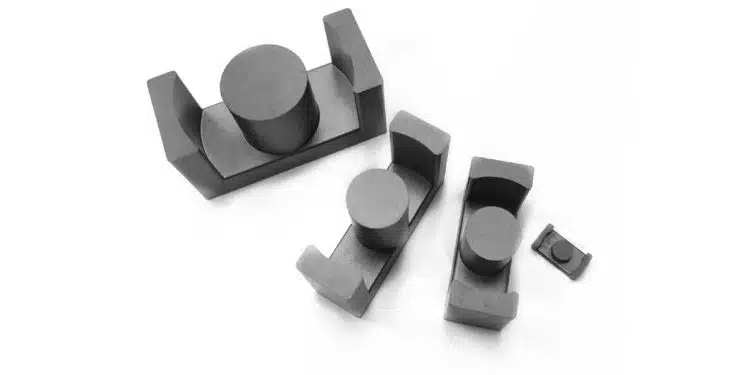In this blog article Pablo Blázquez, Frenetic Power Εlectronics Εngineer is explaining how custom magnetic components can actually give you a competitive advantage and why we should use custom cores.
One of the most important part of the magnetic component is the Core, so today we are going to analyze how and why we should use custom ones.
The first question you’re probably asking yourself is: why do we need custom cores? Well, there are a few reasons:
- Meeting Specific Application Requirements: Off-the-shelf cores might not always deliver the needed performance or characteristics. Custom cores allow engineers to design Magnetics that match the application’s specific needs, including size, shape, material, and magnetic features.
- Boosting Efficiency: Custom cores can be tuned for maximum efficiency. By carefully selecting the core material, shape, and winding configurations, engineers can minimize energy losses in the core and the windings. This helps improve the overall efficiency of magnetic devices.
- Reducing Size: in some cases, size and weight matter a lot. Custom cores can be designed to take up the minimum space possible while still delivering the required magnetic properties. By optimizing the core shape and material, we can achieve miniaturization without compromising performance.
- Unique Shapes and Configurations: custom cores offer the flexibility to create shapes and configurations that aren’t readily available off the shelf. This allows to design magnetic circuits that perfectly fit within the application’s space and mechanical constraints. Unconventional shapes and configurations can improve magnetic coupling, reduce leakage flux, and enhance the overall performance. Although, if you are looking for short lead times, this might not be the best solution…
- Tailored for Specific Frequency Ranges: different applications operate at different frequency ranges. Off-the-shelf cores might not be optimized for a particular frequency, leading to performance limitations. Custom cores can be designed to operate optimally within the desired frequency range, ensuring efficient energy transfer and reducing losses.
- Specialized Applications: some applications have unique requirements that standard cores can’t meet. Think of high-temperature environments, high-frequency power electronics, aerospace systems, and medical devices. Custom cores enable to address these specific needs and design magnetic circuits that can handle extreme conditions or meet all the industry standards.
In a nutshell, custom cores in magnetic design give us the power of tailored performance, improved efficiency, size reduction, unique configurations, frequency optimization, and specialized applications. They offer engineers greater control over magnetic properties, enabling the creation of optimized and high-performance magnetic devices.
But, how do I know what is my best option?
First of all, this question is tricky, as the answer will depend on loads of things, for example, what is the objective of your design, efficiency, size, cost, or all of them together…
We can address this situation in different ways, the first one being the use of our own experience. If you have been designing magnetics components for 30 years in the automotive industry, you will know for sure what shapes work better for you. The second approach involves the use of the Frenetic tool or our design and manufacturing services, that will make the job far easier.
The choice of core shape for a custom core depends on the specific application and its requirements. Here are some common shapes used in magnetic design:
- Toroidal Cores: they are great when we need compactness and high efficiency. Toroidal cores are commonly found in Transformers, Inductors, and Power Supplies.
- E-Core: these cores resemble the letter “E” and consist of three parallel limbs with a central leg that connect them. They are often used in power Transformers and Inductors to improve magnetic coupling and reduce leakage flux.
- U-Core: similar to E-cores, but they lack the central leg, forming a “U” shape instead. U-shaped cores are commonly used in magnetic switches and relays, providing a low-reluctance path for magnetic flux.
- Pot Cores: these cores are cylindrical, with a centered winding window and a closed magnetic path. They’re commonly used in high-frequency applications like switching Power Supplies and RF Transformers. Pot cores help minimize magnetic flux leakage and offer good thermal dissipation.
- ETD Cores: ETD cores have a rectangular or square shape with a centered winding window. They’re commonly used in power Transformers and Inductors for high-frequency applications, striking a balance between compactness and winding space.
- Planar Cores: these are flat cores made of laminated sheets. They find application in planar Transformers, Inductors, and Power Supplies. Planar cores offer a low-profile design, efficient heat dissipation, and good high-frequency characteristics.
- Custom Shapes: depending on specific requirements, custom shapes can be designed to optimize performance. These shapes can vary widely, including complex geometries tailored to the magnetic circuit and space constraints.
Remember, the choice of core shape also depends on factors like operating frequency, power levels, desired magnetic properties, size constraints, and thermal considerations. Engineers select the shape that best meets the application requirements while optimizing factors like magnetic coupling, efficiency, and space utilization.
Summary
In conclusion, custom magnetic components will give you a competitive advantage by increasing performance, improving efficiency, and optimizing size, frequency, and configurations.
Custom Magnetics, in combination with expert guidance, are essential to maximize the benefits as well as having more control over design, making them a great choice in various industries.































